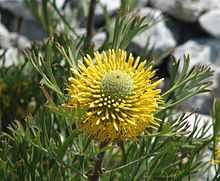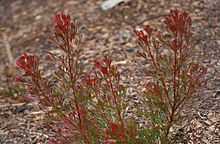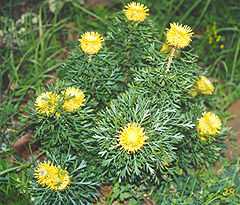Isopogon anemonifolius
| Isopogon anemonifolius | |
|---|---|
 | |
| Scientific classification | |
| Kingdom: | Plantae |
| (unranked): | Angiosperms |
| (unranked): | Eudicots |
| Order: | Proteales |
| Family: | Proteaceae |
| Genus: | Isopogon |
| Species: | I. anemonifolius |
| Binomial name | |
| Isopogon anemonifolius Salisb. (Knight) | |
Isopogon anemonifolius or Broad-leaved Drumsticks is a shrub that is endemic to eastern New South Wales in Australia. In occurs naturally in woodland, open forest and heathland on sandstone soils.
Its height usually ranges between 0.5 and 2 metres, generally being smaller in exposed heathland. The yellow flowers appear during late spring or early summer and are displayed prominently. They are followed by grey cone-like drumsticks, the small hairy seeds found in the old flower parts. The plants leaves are divided and narrow, though broader than the related Isopogon anethifolius, and have a purplish tinge during the cooler seasons.

Cultivation
Isopogon anemonifolius is an easy plant to cultivate in a sandy well-drained soil in a sunny position, though is not as commonly seen as other Australian native plants such as banksias and grevilleas.
Woorikee 2000

Woorikee 2000 is a selected dwarf form of Isopogon anemonifolius, propagated by Bill Molyneux of Austraflora Nursery in Victoria. It is named for "woorikee", the Australian Aboriginal word for the Protea family of plants and the Year 2000.[1]
External links
| Wikimedia Commons has media related to Isopogon anemonifolius. |
- Association of Societies for Growing Australian Plants (ASGAP): Isopogon anemonifolius
- Australian National Botanic Gardens: Isopogon anemonifolius
- New South Wales Flora Online: Isopogon anemonifolius
References
- ↑ Austraflora: Woorikee 2000. Retrieved 11 September 2006.